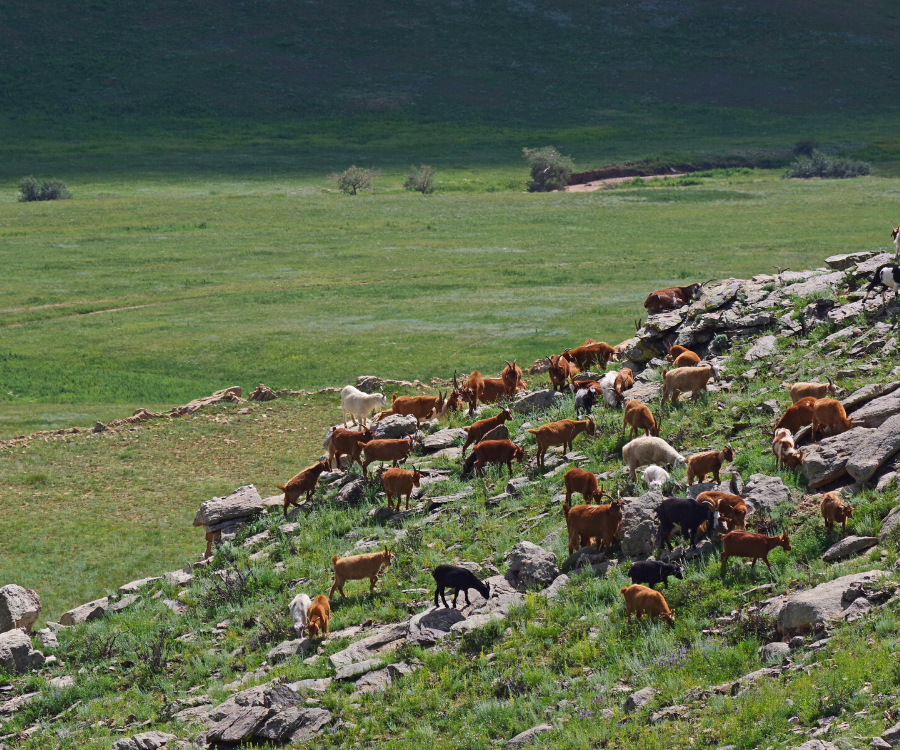Where does cheese come from? When most of us think of artisan cheese, we think of Europe, whose funky, wrinkly, stinky, and savory aged varieties have come to define this food. Or maybe we think of our local cheesemaker here in the U.S., who probably has at least one recipe, if not an entire product line, of cheeses based on European styles.
But cheese’s origins—and the practice of dairy farming and consumption—stretch back far further in human history than these now-common styles. The cheese and dairy industries in the US are dominated by white European-descended farmers and cheesemakers—not including undocumented workers from Mexico and Central America, which are estimated to account for anywhere from 40% to 50% of dairy farm labor. But cheese and other fermented dairy foods have played a foundational role in the developments of civilizations across the Old World for millennia before European cheesemaking traditions spread across the globe with trade, colonization and empire.

The earliest cheesemakers
The Fertile Crescent—the region of Southwest Asia that includes portions of present-day Turkey, Iraq, Iran, Jordan, Lebanon, and Syria—is where humans first began domesticating livestock around 8000 BCE, starting with goats and sheep. Around 7000 BCE, the first cattle were domesticated, and by 6500 BCE, humans had bred the animals they’d originally domesticated for meat and fiber so that they would produce excess milk.
These innovations, combined with a population boom and subsequent depletion of resources in the Levant, caused humans to rely more heavily on grazing livestock in marginal lands where grass, but not crops, would grow. As the population and need for land increased, people migrated into the Western Mediterranean, Central Europe, and west and south through Asia.
During this period, raw milk was primarily used to feed children due to a lack of lactase persistence—the ability to digest lactose, the primary sugar in milk—in adults. But the development of the ability to fire pottery around 7000-6500 BCE meant that milk could now be stored, and milk stored in this warm climate quickly fermented on its own due to the natural presence of lactic acid bacteria. The transformation of lactose into lactic acid is the microbial alchemy that coagulates milk into curds and whey, making it easier for adults to digest.
These unwitting cheesemakers soon found they could use ceramic strainers and baskets to drain off the whey, then consume the curds without experiencing the ill effects of fresh milk. The earliest cheeses would have been eaten fresh, preserved in pots with salt and stored underground, or even dried in the sun. They could also use clay pots to heat fermented milk to make acid-heat coagulated cheeses—the same method used to produce cheeses like ricotta.
Traditional cheeses similar to the earliest varieties are still produced in the region today. In Turkey, a fresh, milky acid-heat coagulated cheese called Lor is used to stuff the flaky pastries called boreka or eaten with fruit preserves or honey for breakfast. Çökelek is a rich, creamy cottage cheese made from yogurt or whey that can be served fresh, dried, or even aged into a blue cheese known as Konya küflü peynir.

How cheese spread around the Old World
People from the earliest cheesemaking cultures migrated through the Balkans and southern Mediterranean and on into Northern Europe. They went west into Egypt; later, in the 8th century CE, the Saracens would travel from North Africa to invade France’s Loire Valley. Their troops were defeated, but their goats and cheesemaking stayed, and the region is now known for its brainlike, wrinkly-rinded goat’s cheeses.
They also went east into India. The Vedas, sacred Hindu texts, include references to making acid-coagulated cheeses as well as using plants to help coagulate milk into cheese—some of the earliest uses of rennet we have on record. It’s theorized that unaged ferments like yogurt and fresh cheeses like paneer took hold in India instead of aged cheeses due to factors like the tropical climate as well as an emphasis on food purity in the Vedas that may have made the controlled decomposition process of aged cheesemaking less appealing.
Cheesemaking and dairying continued further east into Tibet and Mongolia, where hardy, mountain-dwelling yak are raised by nomadic herders who use their milk to produce butter and fresh and dried cheeses. And although evidence of dairy’s presence in the widely varied cuisine of China is somewhat limited, milk cakes were considered a delicacy in parts of southern China during the Ming dynasty in the 14th through 17th centuries. These fresh, pressed cheeses produced via acid-heat coagulation were used to stuff a variety of other foods, from sheetlike noodles to cabbages to whole fish. They were also heated in hot water before being stretched, pasta filata style, into a product called milk threads—produced and sold today as milk fans in Yunnan province.
Dairying has also taken place in Africa since ancient times. Nomadic farmers grazed cattle in the once-verdant Sahara Desert as early as 5000 BCE. A wide variety of traditional fermented dairy foods such as Rwandan ikivuguto, a yogurt-like drink made from cow’s milk, and gariss, as fermented camel’s milk is known in Sudan, make up diets across the continent today. And despite the association of lactase persistence, the ability for adults to digest fresh fluid milk, with European populations, recent research studying populations ranging from East to Southern Africa has identified a slightly different genetic variant there that gives the same effect.
Nutrient-rich, storable, and preservable cheese played an instrumental role in the development of civilizations—some of the earliest known examples of writing are accounts of cheese and butter stores on clay tablets in the Mesopotamian city of Ur around 3000 CE. So as much as the cheesemaking styles and techniques developed in European cultures may have come to dominate the cheese culture around the globe, milk, cheese, and other dairy foods have played a foundational role in cultures across the Old World dating back thousands of years.

Sources:
Cheese and Culture: A History of Cheese and Its Place in Western Civilization, Paul S. Kindstedt
The Oxford Companion to Cheese, ed. Katherine Donnelly

Leave a comment